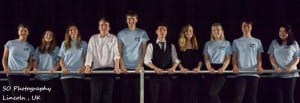Whilst developing ideas and the story of our show, we discovered that the script was becoming more metaphysical than originally expected. This is because we decided it would be interesting to have all characters on stage at all times being themselves and then every time a section was picked so would an actor to portray the character in that scene. This contributed to the game show style that we wanted to portray as it suggests that each actor is a contestant on the game show who gets chosen for the chance to win.
Metaphysical theatre is the ‘physical fact of spectators watching the performer who is in the same room, while, there was also the sense that fictional spaces [are] being created’ (Power, 2008, 3). This is present in Exit This Way as both the actors and the audience know that there is a show happening and the characters that are introduced are fictional and don’t identify with them as they would in a conventional play.
Due to this idea, and after talking to the technicians regarding the set of the show, we decided to use a scaffolding type cage at the back of the stage and two smaller roasters at the front. This created an interesting allusion as the 5 actors on stage were placed under the cage at the back whilst being controlled by the two hosts. The messy style setting of the aesthetic also gradually got more and more chaotic throughout the course of the show which symbolised the failure and deterioration we wanted to show through our theme.
 Initial designs of our set designed using TinkerCad software.
Initial designs of our set designed using TinkerCad software.
(Goddard, 2017)
 Final designs of our set after developments exploring metatheatre
Final designs of our set after developments exploring metatheatre
(Goddard, 2017)
Photos of the final set on tech day
(Goddard, 2017)
This idea was also shown through the costumes we ultimately decided to use. We all had matching t-shirts with our logo and production role on them for fundraising purposes that we wore as part of marketing our show. Consequently, we decided to use these in the actual performance to emphasise the fact that the actors were themselves. As we wanted to make it obvious that we were ourselves, we added personal touches such as our hairstyles and coloured shoes that symbolised our personalities as the show had a personal element about it.
During the creation of each character throughout, we used the technique of layering the costumes on the actor. This creates the allusion the actor is now some form of character, and makes it apparent to the audience they are now not playing themselves. The audience are always aware that though the actor’s t-shirt is masked by a costume, simultaneously the actor is masked by a character and both the character and costume are easily removed at any time during the performance.
Along with metaphysical elements, our show also held a strong post-dramatic sense throughout. A post-dramatic piece of theatre is the idea of a performance that displays ‘the breakdown of dramatic conventions’ (Lehmann, 2006, 1), and one of the main themes throughout ‘Exit This Way’ is this prevalent idea of failure and deconstruction. This was an idea I wanted to show through the set of our show as we wanted to portray this world that looked like it had been made during the show, and letting the audience watch this development or deterioration allows them to understand the positive and negative influences that escapism can have on someone.
An example of the final costumes
(Odonnell, 2017)
Works Cited:
Goddard, C. (2017)
Lehmann, H,T. (2006) Postdramatic Theatre. Oxon, Routledge. Available at: https://books.google.co.uk/books?id=63KBAgAAQBAJ&printsec=frontcover&dq=Postdramatic+Theatre&hl=en&sa=X&redir_esc=y#v=onepage&q=Postdramatic%20Theatre&f=false [Accessed on 1st April 2017].
Odonnell, S. (2017) Fragment Theatre Company. Lincoln: SO Photography.
Power, C. (2008) Presence in Play: A Critique of Theories of Presence in the Theatre. Rodopi. Available from: https://books.google.co.uk/books?id=MbJzjYU10TsC&pg=PA135&dq=metaphysical+theatre&hl=en&sa=X&redir_esc=y#v=onepage&q=metaphysical&f=false [Accessed on 1st April 2017].


Leave a comment